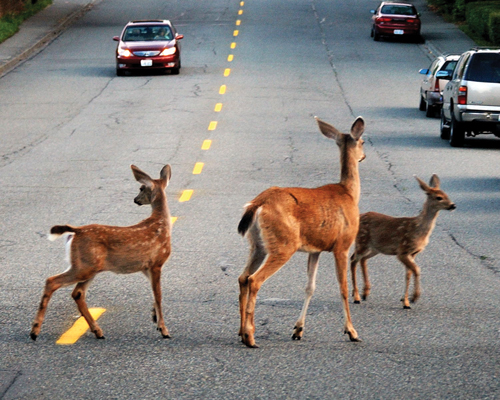 Autumn is here, and along with colorful leaves, crisp air, and shorter days, it means Virginia’s white-tailed deer will be on the move.
Autumn is here, and along with colorful leaves, crisp air, and shorter days, it means Virginia’s white-tailed deer will be on the move.
With daylight savings time just around the corner, many motorists will be commuting in the dark, increasing the likelihood of their vehicle colliding with a deer. The Virginia Department of Game and Inland Fisheries (DGIF) is encouraging Virginia’s drivers to be more cautious as they travel the Commonwealth’s highways this season.
Fall is the breeding season for deer, and consequently, deer are more active now than at any other time of the year. One-half to two-thirds of all deer/vehicle collisions occur in the months of October, November and December. While less than 2 percent of vehicle fatalities and injuries involve deer collisions in Virginia, hitting a deer can cause considerable damage to both people and property.
Wildlife biologists with DGIF estimate the population of white-tailed deer in the Commonwealth at this time of year to be approximately one million animals. DGIF sets seasons and bag limits and other hunting regulations to manage the deer population. Each year, hunters in Virginia harvest approximately 250,000 (a quarter of a million) deer. Without hunting, white-tailed deer could double their population within five years, due to their rate of reproduction.
As part of its outreach mission, DGIF has worked with the Virginia Department of Education to incorporate advice on avoiding collisions into the driver’s education manual used by thousands of new drivers every year. If you have questions about white-tailed deer or deer behavior, please visit the Department’s Web site at http://www.dgif.virginia.gov/wildlife/deer.
The Virginia Department of Game and Inland Fisheries recommend the following tips to drivers to avoid hitting a deer:
1. When driving, particularly at dusk and dawn, slow down and be attentive. If you see one deer, likely there will be others. If one deer crosses the road as you approach, others may follow.
2. Deer habitually travel the same areas; therefore deer crossing signs have been installed by the Virginia Department of Transportation. Use caution when you see these signs.
3. Drivers should apply brakes and stop if necessary to avoid hitting a deer, but should never swerve out of the a lane to miss a deer. A collision with another vehicle, tree or other object is likely to be far more serious than hitting a deer.
4. Rely on your caution and your own senses, not deer whistles you can buy for your car. These devices have not been shown to be effective.
5. Any person involved in a collision with a deer or bear while driving a motor vehicle, thereby killing the animal, should immediately report the accident to a Conservation Police Officer or other law enforcement officer in the county or city where the accident occurred.
6. Drivers who collide with a deer or bear, thereby killing the animal, may keep it for their own use provided that they report the accident to a law enforcement officer where the accident occurred and the officer views the animal and gives the person a possession certificate.
# # #


